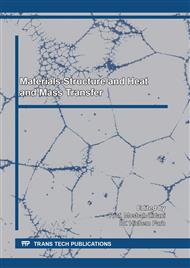[1]
H. LE BRETON, Manuel pratique du fondeur de fonte, DUNOD, Paris, (1966).
Google Scholar
[2]
C. Fragassa, N. Radovic, A. Pavlovic, G. Minak, Comparison of mechanical properties in compacted and spheroidal graphite irons, Tribol. Ind. 38 (2016) 49-59.
Google Scholar
[3]
C.H. Chen, C.J. Alstetter, J.M. Rigsbee, Laser processing of cast iron for enhanced erosion resistance, Metall. Trans A. 15 (1984) 719-728.
DOI: 10.1007/bf02644203
Google Scholar
[4]
A. Gulzar, J.I. Akhter, M. Ahmad, G. Ali, M. Mahmood, M. Ajmal, Microstructure evolution during surface alloying of ductile iron and austempered ductile iron by electron beam melting, Appl. Surf. Sci. 255 (2009) 8527-8532.
DOI: 10.1016/j.apsusc.2009.06.011
Google Scholar
[5]
K.Y. Benyounis, O.M.A. Fakron, J.H. Abboud, A.G. Olabi, M.J.S. Hashmi, Surface melting of nodular cast iron by Nd–YAG laser and TIG, J. Mater. Process. Technol. 170 (2005) 127-132.
DOI: 10.1016/j.jmatprotec.2005.04.108
Google Scholar
[6]
J.R. Davis, Cast Irons: ASM Specialty Handbook, 2nd ed.; ASM International: Materials Park, OH, USA, 1996, pp.393-460.
Google Scholar
[7]
R. Winiczenko, R. Salat, M. Awtoniuk, Estimation of tensile strength of ductile iron friction welded joints using hybrid intelligent methods, Trans. Nonferrous. Met. Soc. 23 (2013) 385-391.
DOI: 10.1016/s1003-6326(13)62474-7
Google Scholar
[8]
R. Konecná, G. Nicoletto, L. Bubenko, S. Fintová, A comparative study of the fatigue behavior of two heat-treated nodular cast irons, Eng. Fract. Mech. 108 (2013) 251-262.
DOI: 10.1016/j.engfracmech.2013.04.017
Google Scholar
[9]
C. Fragassa, Material selection in machine design: The change of cast iron for improving the high-quality in woodworking, J. Mech. Eng. Sci. 231 (2017) 18-30.
Google Scholar
[10]
H. Zhao, J. Li, Z. Zheng, A. Wang, D. Zeng, Y. Miao,The microstructures and tribological properties of composite coatings formed via PTA surface alloying of copper on nodular cast iron, Surf. Coat. Technol. 286 (2016) 303-312.
DOI: 10.1016/j.surfcoat.2015.12.037
Google Scholar
[11]
J. BARRALIS, G. MAEDER, Précis de métallurgie, élaboration, structures, propriétés et normalisation, Five ed.; NATHAN, Paris, (1990).
Google Scholar
[12]
S. Usmani, K.N. Tandon, Evaluation of Thermally Sprayed Coatings under Reciprocating Lubricated Wear Conditions, J. Therm. Spray. Techno. 1 (1992) 249-255.
DOI: 10.1007/bf02646780
Google Scholar
[13]
E.U. Petitbon, J.F. Wallace, Aluminum alloyed gray iron properties at room and elevated temperature, AFS. Cast. Met. Res. J. 9 (1973) 127-134.
Google Scholar
[14]
J.A. Yaker, L.E. Barnes, W.C. Leslie, E.U. Petitbon, Microstructure and strength of Al-containing gray and nodular irons in the range 1200–1800 F (650–980 °C), Trans. Am. Foundrymen. Soc. 84 (1976) 305-320.
Google Scholar
[15]
R.P. Walson, Aluminum-alloyed cast iron, properties and design, Trans. Am. Foundrymen. Soc. 85 (1977) 51-58.
Google Scholar
[16]
R.K. Bhatnagar, G. Gupta, A review on weldability of cast iron, Int. J. Eng. Sci. Res. 7 (2016) 126-131.
Google Scholar
[17]
R. LE GOUIC, Précis de soudage brassage et technique connexes, éditions Eyrolles, Paris, (1978).
Google Scholar
[18]
M. Pouranvari, On the weldability of grey cast iron using nickel based filler metal, Mater. Des. 31 (2010) 3253-3258.
DOI: 10.1016/j.matdes.2010.02.034
Google Scholar
[19]
M. Pascual, C. Ferrer y, E. Rayón, Weldability of spheroidal graphite ductile cast iron using Ni / Ni- Fe electrodes, Revista. Metallurgia. 45 (2009) 334-338.
DOI: 10.3989/revmetalm.0814
Google Scholar
[20]
R.A Jeshvaghani, E. Harati, M. Shamanian, Effects of surface alloying on microstructure and wear behavior of ductile iron surface-modified with a nickel-based alloy using shielded metal arc welding, Mater. Des. 32 (2011) 1531-1536.
DOI: 10.1016/j.matdes.2010.10.006
Google Scholar
[21]
X. Qi, S. Zhu, H. Ding, Z. Zhu, Z. Han, Microstructure and wear behaviors of WC–12%Co coating deposited on ductile iron by electric contact surface strengthening, Appl. Surf. Sci. 282 (2013) 672-679.
DOI: 10.1016/j.apsusc.2013.06.032
Google Scholar
[22]
M. Ksiazek, K. Boron, M. Radecka, M. Richert, & A. Tchorz, Mechanical and Tribological Properties of HVOF-Sprayed (Cr3C2-NiCr+Ni) Composite Coating on Ductile Cast Iron, J. Mater. Eng. Perform. 25 (2016) 3185-3193.
DOI: 10.1007/s11665-016-2226-x
Google Scholar
[23]
Y. Adda, J. Philiber, La diffusion dans les solides tome II, DUNOD, Saclay, Paris, (1966).
Google Scholar
[24]
R.C. Voigt, C.R. Loper, A study of heat-affected zone structures in ductile cast iron, Weld. J. 42 (1983) 82-88.
Google Scholar
[25]
E.R.I. Mahmoud, H.F. El-Labban, Microstructure and Wear Behavior of TiC Coating Deposited on Spheroidized Graphite Cast Iron Using Laser Surfacing, Eng. Techno. Appl. Sci. Res. 4 (2014) 696-701.
DOI: 10.48084/etasr.483
Google Scholar
[26]
S. Kim, S. Lee, K. Han, S. Hong, C. Lee, Cracking Behavior in a Dissimilar Weld between High Silicon Nodular Cast Iron and Ferritic Stainless Steel, Met. Mater Int. 16 (2010) 483-488.
DOI: 10.1007/s12540-010-0621-7
Google Scholar
[27]
C.D. Lundin, W. Liu, G. Zhou, C.Y.P. Qiao, Unmixed Zone in Arc Welds: Significance on Corrosion Resistance of High Molybdenum Stainless Steels, Welding Research Council Bulletin 428, New York, (1998).
Google Scholar
[28]
L. Cárcel-Carrasco, M. Pascual, M. Pérez-Puig, F. Segovia, Comparative study of TIG and SMAW root welding passes on ductile iron cast weldability, Metalurgija. 56 (2017) 91-93.
Google Scholar


